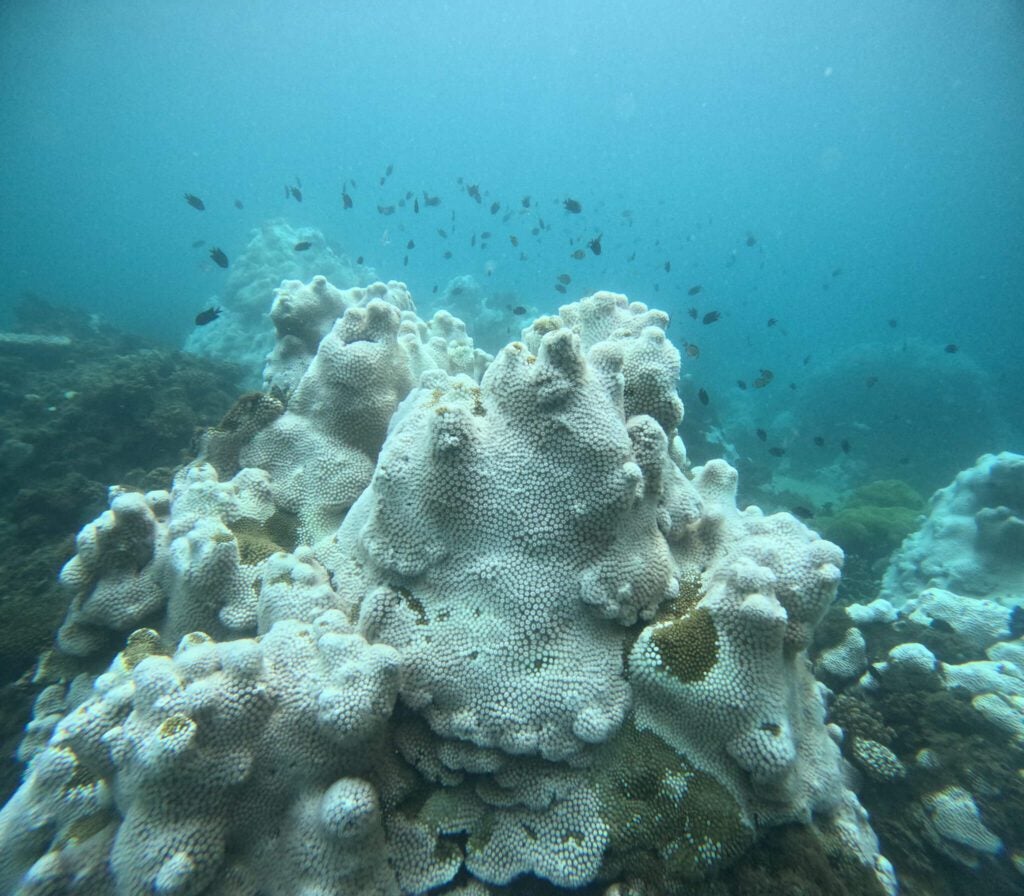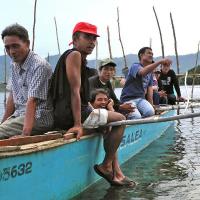January 8, 2025
Ask a Scientist: Can you explain coral bleaching?
Diovanie “Diuvs” De Jesus, Campaign and Science Specialist, Philippines
Diovanie “Diuvs” De Jesus started sailing with Oceana in the Philippines as a Marine Scientist and now as a Campaign and Science Specialist, providing scientific insights and strategies for campaigns. His passion for saving the oceans is matched by his love for exploring the breathtaking waters of the archipelago, where he dives into adventure and discovery.


Alvin Simon, Research Scientist, Philippines
Alvin Simon is a Research Scientist for Oceana’s campaign research department in the Philippines. Prior to joining Oceana, he was a researcher under several national projects monitoring the status of coral reefs. He specializes in reef fish ecology and has worked with some of the top Filipino marine scientists.
Although corals may look like rocks, they are actually living organisms, engaged in a vital relationship with microscopic algae called zooxanthellae, which provide corals with food through photosynthesis and give them their vibrant colors. This intricate bond, however, is under threat. When ocean temperatures exceed their normal range — increasingly due to climate change — corals experience extreme stress and expel their zooxanthellae. This leaves them “bleached” and vulnerable, since the sugars they get from the zooxanthellae’s photosynthesis are their primary food supply. While some corals are more resilient and can recover from bleaching, others will eventually die if stress-inducing conditions continue.
Coral reefs are the breeding and nursery grounds for a wide range of animals like the giant clam, blue swimming crab, and fish like sardine and grouper. Coral reefs are also home to manta rays, turtles, dolphins, and more — so when corals bleach, the entire ecosystem feels the impact. Bleaching events have become more frequent and severe, posing an ever-increasing threat to coral reefs.
Coral bleaching in the Philippines

For the people of the Philippines, coral bleaching is not just an environmental issue — it’s a human one — threatening the livelihoods of millions of Filipinos who depend on healthy reefs for food and economic survival. Dying and dead reefs result in lower fish catches for artisanal fisherfolks and hurt the country’s tourism industry, which is a major economic player and highly reliant on healthy reefs. Moreover, the loss of coral reefs, which act as a natural barrier against waves, puts coastal communities at risk of storm surges and erosion.
Philippine reefs have suffered through several mass bleaching events over the years. In 1998, a global bleaching event hit one of the most important coral reefs in the country, Tubbataha Reefs Natural Park. Ninety percent of the corals turned white in Apo Island Marine Reserve in Negros Oriental, the oldest marine reserve in the country. Coral cover declined dramatically and some of the reefs never recovered.
In 2008, bleaching came to Apo Reef Natural Park, a major diving destination for tourists who come to see the reefs and the manta rays, whale sharks, and sea turtles that call it home.
The coral reefs of Verde Island Passage, an epicenter of marine reef fish biodiversity, bleached in 2010. Bleaching events in 2016 and 2021 also affected areas in the Sulu Sea, Visayan Sea, Palawan, and Tawi-Tawi.
And in early 2024, marine scientists observed extensive coral damage in the West Philippines Sea, an area in contention with China and other neighboring countries, with almost 100% of the corals dead or in different stages of dying.
Protecting corals
The frequency of coral bleaching events is alarming and made worse by the increasing climate crisis. Oceana is at the forefront of campaigns to safeguard these critical marine ecosystems.
One of our most pressing initiatives is to establish marine protected areas to create spaces where marine life are safe from overfishing and other destructive human activities. By removing these threats, we can enhance the resilience of corals in the face of climate change. Reefs protected from overfishing and other threats are more likely to recover from bleaching events, or avoid them altogether.
Oceana was invited by the Philippines government in 2016 to participate in an expedition to the Philippine Rise, a coral reef system located in deep waters. Unlike shallow reefs, the coral reefs in the Philippine Rise are remote and inhabit cooler, deeper waters; as a result, they are protected from direct human threats and are less vulnerable to rising sea temperatures. This collaboration led to the establishment of the Philippine Rise Marine Resource Reserve in 2018. Protecting and studying this resilient area is critical and offers hope that some ecosystems can withstand the impacts of climate change.
Oceana is also campaigning to establish the Panaon Island Protected Seascape in Southern Leyte, Philippines, an area that boasts a coral cover surpassing the national average. It is part of the 50 Reefs Initiative, a global effort led by Bloomberg Philanthropies and other partners to protect the world’s most climate-resilient coral reefs.
By safeguarding vital habitats in the Philippines from illegal fishing, overfishing, plastic pollution, and unsustainable coastal development — such as ‘dump-and-fill’ projects — Oceana can ensure that marine ecosystems remain healthy and abundant into the future.



